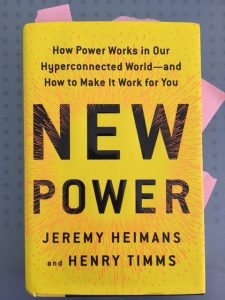 Yesterday was our kickoff meeting for the new internal/external HBG Book Club, and I was kind of nervous.
Yesterday was our kickoff meeting for the new internal/external HBG Book Club, and I was kind of nervous.
It wasn’t about the chosen book, New Power, or about having read my chapters (I did!). I wasn’t nervous about whether the ‘old’ and ‘new’ book club members would mesh, or if there would be enough discussion.
What I was worried about was the thing I couldn’t control – the technology we used to meet up. Earlier this month, we subscribed to a video conferencing service that we’ve been using the freebie version of for a while. In order to bring new, non-HBG people into the book club, we needed to commit to the fee-based version. New audio, video, and chat platforms.
I’m fairly technologically savvy, but, you know, there’s a lot that can go wrong. As I like to say, technology is great – when it works.
Nervous doesn’t begin to cover it
Like quite a few brave other people last week, a member of my team presented at the Apra conference in Pittsburgh, having never presented before. With eight concurrent sessions and over 1,000 people in attendance, even an eighth of that crowd is a lot of people to face for your first-ever presentation. And then there’s the question of whether the PowerPoint will load, if it will forward and advance, and if the microphone will work. Oh, and the internet, too. What if that decides to go offline just for fun?
It’s not easy. Nervous doesn’t begin to cover it, and as human beings we tend not to like (and not to do) things that we can’t control. Unless we’re forced to.
When we think whatever we dread is going to be the End of The World, we can feel good about the fact that the only thing that’s the End of the World is … the actual End of the World.
And fingers crossed that we have some time yet before that happens. Chances are good that fundraisers and prospect development pros aren’t going to be the cause, so, hey – there’s another thing to feel good about.
It wasn’t the end of the world. But it was still nervous-making.
But, you know, book club went great and my teammate survived. The technology worked. People gathered, talked, and learned stuff. By all accounts my teammate did a great job relaying knowledge and being a resource for others. We all connected to discuss something we’re interested in, that we care about. We built networks and forged connections. That’s very New Power.
We’re only a couple of chapters in, but some of the early takeaways from New Power are how important it is for organizations, both for-profit and non-profits, to understand what Old Power and New Power are, and to creatively channel the best of each to strengthen living, sustainable organizations.
Old Power is hierarchical – it’s top down organizational structures that concentrate power (or money or information) amongst a few and parse it out sparingly. We’re all used to Old Power, whether in the form of government bureaucracy (think of your most recent experience in the RMV) or pretty much any company. There’s a lot that is controlled. I think of it as a very Boomer-and-before power structure.
New Power is “open, participatory, and peer driven.” Think #MeToo, which helped topple Harvey Weinstein; or Patients Like Me, an online community where people share medical data and personal experience to crowdsource treatments and cures. New Power is very social-media based and technologically savvy. Because of the collaborative nature of New Power, there’s a lot that individuals can’t control but each of us is participating in the powerful current flowing through the movement we’re part of. As a generational descriptor, I think of it as very Gen-X and after.*
New Power is nervous making, right? It feels technology-based and, like Old Power, there’s a lot one individual can’t control – but with New Power it’s the collective that can have impact. This collective impact is exactly what makes it extraordinarily interesting to watch unfold and, as with all uncomfortable situations, it’s kind of exhilarating and teaches you a bunch of stuff, about yourself, about others, and about the power you wield.
Old Power and New Power aren’t mutually exclusive, and we’ve learned early on that neither is all bad or all good. I know we’re going to learn more as we read further but if I had to guess, I’d say that authors Henry Timms and Jeremy Heimans are going to show us that the most successful organizations are ones that have figured out how to harness and channel the power of each.
I’m really excited to see what the rest of this book brings. I hope that you’ll read it along with us and share your thoughts using the hashtag #HBGBookClub.
*Disclaimer disclaimer yadda yadda: I know that not all Boomers are Old Power and not all Millennials are New.
